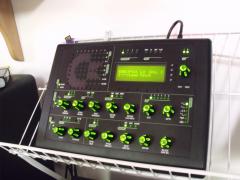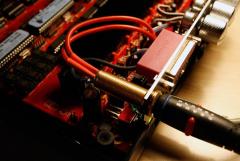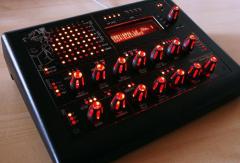-
Posts
3,633 -
Joined
-
Last visited
-
Days Won
36
Content Type
Profiles
Forums
Blogs
Gallery
Everything posted by Hawkeye
-
-

Mb6582 plus 4 SSM2044 VCFs - use of a passive 4 channel stereo mixer?
Hawkeye replied to Hermes's topic in MIDIbox SID
Addendum - had a little intermezzo with some opamps a few weeks ago ´cause I needed to repair a mackie mixer channel strip with a dead one... it is not difficult to understand how it works even for an electronics noob like me... for line-level sources (no mic-preamps, no eq stage) a simple active mixer is quite easy to create. Best regards, Peter -

Mb6582 plus 4 SSM2044 VCFs - use of a passive 4 channel stereo mixer?
Hawkeye replied to Hermes's topic in MIDIbox SID
Hi, imho this is not worth 50 bucks for just four 100k pots and a few sockets... you could just use the same passive mixer design as in the MB6582 - use 10k resistors on every channel and chain them together, it is good for 8 channels and should also good for two times 4 channels (just try it out) best regards, Peter -
Hi Ciro, looks like you don´t have MSYS "Unix Tools" installed. They provide what it is necessary for building the stuff. Look here under "Required Tools": http://www.midibox.org/dokuwiki/doku.php?id=windows_toolchain_core Best regards, Peter
-
Yes, it stays the same - I navigated to different patches meanwhile and came back to verify... Are you sure you didn´t just "upload to buffer"? It only stores the patch in "volatile" memory, in that case you need to save it manually from the MIDIbox... The other upload method ("upload to memory") directly writes to the bankstick and it should be conserved there for some time... Best regards. Peter
-
Hi there, first of all, thanks for sharing the patch... As far as I´ve understood in Multi Engine Mode (I don´t use it usually :-)), there are no single oscillators configurable (as you´ve described in the last post), but six different "instruments" that are mapped to the three oscillators of the two SIDs. You can address these instruments via different MIDI channels (and you did that in the demo midi file). You can configure those instruments of course with different oscillators and you did that, so I guess it is just a "naming misunderstanding" in the last post. When I open your multi patch in Rutgers Librarian instrument 1 uses a square instrument 2 uses triangle, sync and ring mod instrument 3+4 use square with different sustain levels instrument 5+6 use triangle with different sustain and release levels Does this match your intended patch? If so, the displaying in Rutgers Editor is correct - also the uploaded patch appears to be identical, when uploaded to a MB6582. I uploaded it by selecting to the appropriate bank slot (A 56 in my case) in the java editor, followed by "file -> load patch -> your patch file" and then "transmit -> patch to memory". So, no problems in uploading to a MB6582 on my side. Nice demo midi track btw! Best regards, Peter
-
-
Yo and this f´up thread is tha proper place for uploading new patchez :-)
-
-

Building the MB-6582 Control Surface - Photo Tutorial
Hawkeye replied to Hawkeye's topic in Tips & Tricks
Conclusion (II) That´s it once again. Despite the CNCed plexiglass window screen, which I hope to obtain at some point in time, I cannot think of any other improvements to this fantastic synth. See image two for an overview of how a plexiglass window can be glued to the aluminum frontpanel from the backside. Thanks for the illustration, orange_hand! Enjoy & I hope you found the tutorial extension useful. Edit: Added a night studio shot with purple/white VFD filtering, which I like the most right now :-) Best regards, Peter -

Building the MB-6582 Control Surface - Photo Tutorial
Hawkeye replied to Hawkeye's topic in Tips & Tricks
Step 22: Building a new protected linear PSU Notes: * Why upgrade from your old C64 PSU? Because it is old. And it contains an unprotected 20+ year old voltage regulator, that in a failure scenario will lead to a real mess - it will pump too high voltage through your MB6582, probably frying SIDs, your display and potentially the PICs. Not nice! * On the other hand... working with high voltage and PSUs is really dangerous! Be extremely sure, that you know what you do. If you are not, you can always buy (rather expensive) linear PSUs commercially. Or you can go for a cheaper "switching" PSU, which may (or may not, the discussion is endless) introduce audible noise to your signal path. The costs for this PSU were less than 50€ and it is really nice: - It contains a high-power 5V regulator (up to 2 Amps) and has more than enough power on the 9V rail (nearly 3 Amps). - It is fused to the max :-), with a total of four fuses in the PSU. - It also contains a "crowbar-protection circuit". In case of a catastrophic VR failure (aka over voltage), a thrysistor will short circuit the 5V rail and blow a fuse. - It contains LEDs for +5V and the active protection circuit. - It contains "long livable" capacitators - high temperature variants, that you would normally not get in "consumer hardware". - The case is nice and very sturdy. Description: * This build is nearly identical to the description from retro-donald.de: http://www.retro-don...wernetzteil.php * You can test the crowbar circuit (Picture 13) with a lab PSU - I did so. It triggers when 6.2V are reached (simulated catastrophic VR failure) and shorts the rail. Very nice :-). You could also create the crowbar circuit for the 5V rail as a standalone separate unit (with a fuse!) and reuse your old C64 PSU. * I will not cover the build details this time, because of two reasons... first, you really need to know what you are doing - and second, I won´t take any responsibility for damages (to you or your environment) by reproducing the PSU. So please accept this as a mere picture gallery - no build description and part list this time! -
-

Building the MB-6582 Control Surface - Photo Tutorial
Hawkeye replied to Hawkeye's topic in Tips & Tricks
Step 21: Installing a studio-compliant 6.3mm stereo socket (passive mixer) Parts Used: * Göldo J002G 1/4 inch/6.3mm gold stereo socket (Thomann audio store, for example) * A length of wire and heat shrink tube * A 12mm drill, a countersinking cutter will do nicely ("Senkbohrer" in german) * A roll of electrical insulating tape * Your favourite soldering equipment Description: * First, extend the hole for the old 3.5mm socket to 12mm (photo 1 before modification and 2 after drilling). * Install the stereo socket * Solder wires to the passive mixer audio-out headers - no plug is necessary in my opinion - protect pins by putting on some heat shrink tube (photo 3). * Finally solder wires to the stereo socket, protect them with heat shrink tube and protect the whole socket with a layer of insulating tape (photo 4) for sanity reasons - the case closes nicely and neither the CS nor the display touches the new socket, so it is probably not necessary. Enjoy your better studio connectivity :-) -

6.3mm Stereo Socket for MB6582 Passive Mixer Output
Hawkeye posted a gallery image in Members Gallery
From the album: Hawkeyes MB stuff
It fits perfectly... If you don´t have 8 mixer channels left, then this is the next best alternative to connect the MB6582 to your studio... The case closes without problems and there are no contacts to the CS PCB or the display. (-> See photo tutorial for more infos) -
Thx, dude! Methinks, I know your emerald green one from facebook - very nice! It inspired me to do the red one :-) That brightness control is very cool - I have a spare LM317 + 10k pot, but for now am happy that the CS and the Frontpanel are back together :-) I´ve added your suggestion to the tutorial for other illumination crazies - thanks for reporting it! Bye, Peter
-

Yakuza - our latest song using NES, OPL3, and the SID
Hawkeye replied to m00dawg's topic in Songs & Sounds
+1 likes :) well done! -
go Smithy, go! sorry for ot... still very interested in the patch :poke: :flowers:
-
-
-
-
Thanks a lot for your responses :-) They made me very happy :-) It is only that bright, when its quite dark in the studio (long exposure here) - you don´t see the LEDs shining through the knobs - also I adjusted the resistors for the "normal LEDs" to match the brightness of the knobs (220R). The VFD on the other hand is really bright, which is nice because it can be filtered to nearly all colors and still retains enough photon emission to be stunning - it is a really recommended upgrade from a standard LCD :-).
-
Just follow the trace where your solder pad came off to the next pad. Solder one end of a short wire there and the other end to your corrected resistor, where the pad came off.
-
The sammich sure is a good starting point, you can control it via external MIDI controllers nicely. The MB6582 is good for higher polyphony in lead instruments. As a very interesting scalable alternative you can only build the MB6582 baseboard and add SIDs as you go can obtain them - and control everything via MIDI or the Rutgers Patch manager. Regarding the manual - the MBSID V2 manual is it - the MB6582 is "just" an awesome integrated/non-modular variant of it.
-
MB6582: ca 500-800€ depending on your component sourcing & customs duty avoiding abilities, component-type (encoders and display can make it cheaper or more expensive) and general pimping desires :-) Hours: you can do the baseboard in one night. The CS takes a little bit longer (I would guess ca 10-20 hours). Greets, Peter
-
From the album: Hawkeyes MB stuff
Using a color foil for VFD hue-shifting. Including a space invaders alien. Hope you like it. Outstanding work TK. & Wilba - Thanks once again!




























